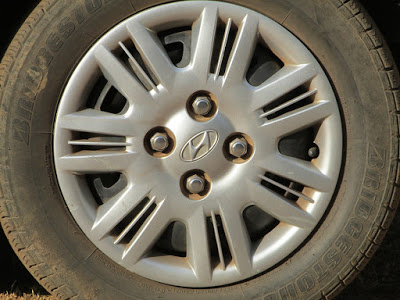 TIRE BROWNING
TIRE BROWNING
Ever wondered why some tires have that brown shade? And wondered how to get rid of that unsightly color? Some of you may notice that some car tires slightly turn brown over time, this is caused by an organic compound in the tire known as antiozonant. Used in almost all exterior rubber and plastic products to some degree it slows down the deterioration of the product, so it does not crack, become dry or brittle.
For tires, the antiozonant protects and slows down the degradation of the tire from the elements, UV rays, and Ozone in the air. This extends the life of the tire by preventing cracking, splitting and oxidation of the tire’s surface.
The browning occurs because the antiozonant is constantly being pushed outside, to the surface of the tire, and when it is exposed to the air, moisture and elements it turns to a brown shade. This is known as tire browning or tire blooming. This may seem unpleasant, but with antiozonant it is possible to have high mileage and high-performance tires.
HOW TO GET RID OF TIRE BROWNING
Washing a car tire may seem like a dull and unnecessary task since the tire is constantly exposed to the road and other elements. But imagine having a well dressed suit or dress, a dull and discoloured shoe can throw the entire outfit off! Cleaning the tire properly not only extends its life but it also enhances the overall image of the automotive. It is something you need to do to maximise the full potential of the look of your car.
To get rid of tire blooming / browning and giving your tires that black look like it was brand new, the first step you must do is to get the tires clean. You can see the steps to properly cleaning a tire here.
Think of this process as exfoliating. The browning may be stubborn and require some excessive scrubbing if the tire has not been cleaned in awhile or never at all. The surface needs to be clean so that the dressing is able to bond properly.
If there are still some minor browning present you do not have to fear, as you can use a tire dressing otherwise known as shine to mask it up. There are two types of tire shine, a water-based and solvent-based.
WATER-BASED TIRE DRESSING
The water-based is widely popular because it is dilutable and cheaper than the solvent-based. It adds a non-greasy satin finish, not as shiny as the solvent-based, it has more of a natural look. It is environmentally friendly and has UV blocking capabilities. However, it is not as durable as the solvent-based.
SOLVENT-BASED TIRE DRESSING
The solvent-based dressing adds a greasy thin layer onto the tire that has a super glossy appearance. It is more durable and can withstand a few washes and rain. The protectant does last longer but It also adds extra work to the next cleaning time, being non-biodegradable. Make sure you read the instructions, each has their own chemical composition. Use a good tire conditioner, keeping it healthy.
To apply the dressing/shine onto the tire, apply a small portion on a sponge or microfiber pad and dab it all along the sidewall of the tire evenly. Go over the sidewall in circular motions to cover the sidewall in the solution.
Let the solution cure for 5-10 minutes and then lightly buff any excess solution with a clean cloth. Alternatively, the tire shine also comes in a spray applicator. When using this be careful of getting any excess spray on the wheels and paint. Wipe off immediately with a clean cloth.
Do not apply the solution on the tread of the tire and avoid rainy days. Be careful not to get any on the brakes and pads, and if you have aftermarket tire lettering decals, you would have to check the instructions.
Like the wax coat of the body of the car, you are able to protect the tire from the elements and slow down as well as covering up any browning. Properly washing the tire the first time makes it easier to clean the tire the next time around.
Each type of tyre has a different amount of blooming. Some will bloom faster than others. Like washing the rest of your car and Car Service, you may need to keep a check on your tires fortnightly – monthly for that visual enhancement.

